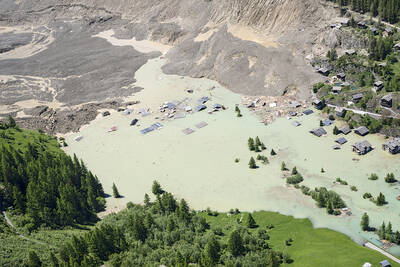A coral-killing starfish has begun infesting a channel of water in the Philippines famed for having some of the most diverse marine life in the world, the government said on Friday.
The appearance of the crown-of-thorns starfish in the Verde Island Passage could cause great damage to the area’s biodiversity, said Jacob Meimban, head of the wildlife bureau’s coastal marine management office.
“The crown-of-thorns starfish really kills the corals. It eats the polyps of the corals, leaving the bleached, white bodies. Then it moves elsewhere ... until it leaves the reef dead,” Meimban said.
Marine biologists have described the passage, which is 100km long and 20 km wide, as the “center of the center” of the world’s ocean biodiversity.
It is at the top of the Coral Triangle, an area of water spanning down to Indonesia, Papua New Guinea and East Timor that is called the “Amazon of the Seas” because of its rich marine life.
However, environmentalists have also warned for years that the passage, a popular dive location, is under grave threat from pollution and overfishing.
It is one of the busiest waterways in the Philippines, with its waters plied daily by oil and chemical carriers.
On nearby shores there are shipyards, chemical, oil refineries and big populations.
Meimban said the starfish had been detected in large numbers for the first time in recent months.
He said they may have boomed because of overfishing, which removed many of its natural predators, and siltation, which brings nutrients to the sea that encourage their growth.
He said two dives in the Verde Island passage since April had found at least 500m2 of corals ruined by the starfish, but they did not have enough divers to determine the full extent of the damage.
The wildlife bureau has tapped local volunteers, university students and the coastguard for divers to start removing the starfish.
“But we need more divers,” he said.
Removing the starfish requires divers to laboriously pick them up one-by-one with metal tongs, then bring them to shore for burial, he said.
Marine biologists say the crown-of-thorns starfish has been a recurring threat to coral reefs around the world for decades.

The collapse of the Swiss Birch glacier serves as a chilling warning of the escalating dangers faced by communities worldwide living under the shadow of fragile ice, particularly in Asia, experts said. Footage of the collapse on Wednesday showed a huge cloud of ice and rubble hurtling down the mountainside into the hamlet of Blatten. Swiss Development Cooperation disaster risk reduction adviser Ali Neumann said that while the role of climate change in the case of Blatten “still needs to be investigated,” the wider impacts were clear on the cryosphere — the part of the world covered by frozen water. “Climate change and

Poland is set to hold a presidential runoff election today between two candidates offering starkly different visions for the country’s future. The winner would succeed Polish President Andrzej Duda, a conservative who is finishing his second and final term. The outcome would determine whether Poland embraces a nationalist populist trajectory or pivots more fully toward liberal, pro-European policies. An exit poll by Ipsos would be released when polls close today at 9pm local time, with a margin of error of plus or minus 2 percentage points. Final results are expected tomorrow. Whoever wins can be expected to either help or hinder the

DENIAL: Musk said that the ‘New York Times was lying their ass off,’ after it reported he used so much drugs that he developed bladder problems Elon Musk on Saturday denied a report that he used ketamine and other drugs extensively last year on the US presidential campaign trail. The New York Times on Friday reported that the billionaire adviser to US President Donald Trump used so much ketamine, a powerful anesthetic, that he developed bladder problems. The newspaper said the world’s richest person also took ecstasy and mushrooms, and traveled with a pill box last year, adding that it was not known whether Musk also took drugs while heading the so-called US Department of Government Efficiency (DOGE) after Trump took power in January. In a

It turns out that looming collision between our Milky Way and Andromeda galaxies might not happen after all. Astronomers on Monday said that the probability of the two spiral galaxies colliding is less than previously thought, with a 50-50 chance within the next 10 billion years. That is essentially a coin flip, but still better odds than previous estimates and farther out in time. “As it stands, proclamations of the impending demise of our galaxy seem greatly exaggerated,” the Finnish-led team wrote in a study appearing in Nature Astronomy. While good news for the Milky Way galaxy, the latest forecast might be moot